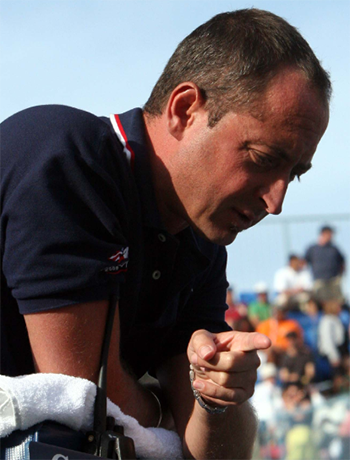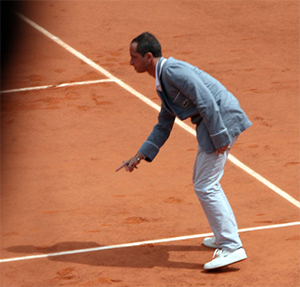VIEW AND DOWNLOAD WORLD TENNIS GAZETTE VOL. 10 NO. 4

Pointing out a missed shot, Umpire Pascal Maria looks down from his chair.
By JOHN MARTIN
March 2019
Who can forget the argument at the 2018 U.S. Open women’s final between an angry Serena Williams and a duty-driven chair umpire, Carlos Ramos?
Whether you had a front-row seat in the photographers’ pit or watched from your living room couch as cameras and microphones swarmed around them, the spectacle won’t soon fade away.
Tennis fans are no strangers to tantrums or tirades, but the moment usually passes with little introspection or even recollection.
Williams’ outburst, which included calling Ramos a “thief” and “liar” and repeatedly demanding an apology, was carried out in an angry tone that was audible to millions.
Ultimately, it led to a series of match-ending exchanges that stunned the tennis universe as have few sports altercations in modern history.
Condemnations flew from all directions. USTA President Katrina Adams criticized Ramos’s rigidity, then eased back in mild apology that managed to infuriate umpires and line judges. One veteran umpire exclaimed that Adams had thrown Ramos and his fellow rules keepers “under the bus.”
The New York Times Columnist Juliet Macur wrote an analysis headlined “Serena Williams Picks the Wrong Time to Make the Right Point.”
Williams insisted that men are rarely punished so severely for similar behavior, that coaching violations — actions admitted by her coach but denied repeatedly by Williams — are routinely ignored in men’s matches.
The debate ultimately sank beneath waves of recrimination.
Questions arose: “Are men given softer treatment or harsher? Why do some players consistently engage in verbal abuse? Are they interrupting play merely as a way of throwing their opponents off stride? What’s behind their behavior?
A review of tennis histories and newspaper and magazine accounts suggests that over the early years of the Open Era, perhaps half-a-dozen players, mostly men, established careers marked by extreme outbursts.
“You cannot be serious!” John McEnroe’s repeated shout remains among the most memorable and bellicose. It happened in a 1981 match at Wimbledon.
“Jerk!” he added, sticking with his tone of disbelief at a linesman’s call upheld by the chair umpire.
What few recall from his first-round match that same Wimbledon was the crude slur McEnroe aimed at Chair Umpire Ted James. He called him “pits of the world,” for which he was fined $14,750.
Initially, the French seemed more lenient. In 1983, they assessed McEnroe $3,350 for kicking a photographer’s camera and shouting obscenities at a chair umpire. Eight years later, he was still at it, “profoundly sassing” a Wimbledon line judge at a cost of $10,000, according to Bud Collins’ Tennis Encyclopedia.
So it’s not surprising that McEnroe, one of the tennis world’s most recognizable disputants, recently said Serena Williams had no reason to apologize.
“To who?,” he ungrammatically asked Tennis World reporter Luigi Gatto.
“She used a lot of cards. If ‘thief’ is the worst word she used, I have got some bad news for you.
“There are a lot of other players, including myself…that have done far worse.”
McEnroe was on safe ground even if he was speaking of his own tantrums alone. One year in the 1980s, he forfeited nearly $200,000 in prize money to pay fines for outrageous behavior. (Serena Williams was fined $17,000 for her behavior toward Umpire Ramos).
The rough estimate of McEnroe’s penalties ($611,742 in 2018 dollars) is from Bud Collins, the authoritative editor and author of three remarkable histories of tennis.
Few skirmishes escaped Collins in his lengthy career at The Boston Globe and NBC News’s long-running Breakfast at Wimbledon.
One amusing but little reported scuffle happened at the French Open in 2009. Fernando Gonzalez of Chile added a maneuver to the list of over-the-top complaints: Challenging a line call, he walked to the area, sat down on the clay, and rubbed his posterior over the disputed spot.
The call, of course, stood. But Gonzalez sat. And then he rose to resume his semifinal match, which had halted for a changeover.
Gonzalez protested or glared at many calls in his loss to Robin Soderling of Sweden, but his sit-down gesture topped (or bottomed) them all.
In his heyday of the 1970s, Ilie Nastase of Romania was one of the most notorious disrupters of matches, Collins noted.
Once he faced the chair and spat during a U.S. Open match. Another time, he placed a racket between his legs in an obscene gesture.
“Nastase was a player who exploded easily and walked out of numerous tournaments,” wrote Collins. One time, he reported, Nastase literally ran out of a match.
It happened in London one year. Nastase’s gamesmanship so completely infuriated his opponent, Clark Graebner, that Graebner “crossed over the net and offered to flatten Ilie if he didn’t behave. Nastase fled the court.”
Jimmy Connors, influenced by Nastase, once scuffed away a mark that might have cost him a point, according to Steve Flink, a former editor of World Tennis Magazine and a columnist for the Tennis Channel.

Early in his career, Umpire Pascal Maria was hospitalized when struck by a racquet thrown by an angry player at the French Open. He retired in 2017 after umpiring 11 major championship finals. He is a native of France.
It was during the semifinals of the 1977 U.S. Open, Flink recalled, when Forest Hills’ courts were made of gritty, greenish particles that served as the American version of clay.
Corrado Barazzutti of Italy was the victim of that incident, Flink said. He had pointed to a mark outside the line and invited the chair umpire to inspect it.
“Connors ran over and moved his shoe over the mark, and smirked, as if to say, ‘Well, we won’t have this to worry about,’ ” said Flink, a member of the International Tennis Hall of Fame.
Connors often acted to antagonize the crowd as well as the chair umpire. There were deep psychological reasons, according to a lengthy article in the January, 1978 issue of Sport magazine. Its headline: “The Self-Destruction of Jimmy Connors.”
Journalist Marty Bell wrote “He had turned this event (the U.S. Open) into a summary of his stormy career by alternately dazzling people with his tennis and offending them with his antics. This dichotomy has always been present in his complex nature.
“It seems he needs to be unpopular so he systematically puts off everyone until he stands by himself against the world.”
Connors could be moody. So could the mercurial Pancho Gonzalez. After spending several days on the road with Gonzalez as he barnstormed the country playing Lew Hoad in 1958, the sportswriter and broadcaster Dick Schaap wrote:
“Popularity has never been one of Gonzalez’s goals. On the tennis court he is powerful and quick. Off the court he is a riddle, a man alone against the world.”
One of Gonzalez’s contemporaries described how he once gained revenge for what he perceived as a series of mistaken calls.
Ted Schroeder, the U.S. men’s champion in1942 and the Wimbledon titlist in1949, said Gonzales once went into a slow boil over calls that were going against him.
Angry at the chair umpire, Gonzales looked for a way to respond, Schroeder said. Finally, on a changeover, Gonzales approached the umpire’s chair and looked up. The umpire looked down. Suddenly, Gonzalez swung his racket, decapitating the umpire’s microphone.
“Officiating can be dangerous,” reported Collins’s Tennis Encyclopedia, co-authored by Zander Hollander. It describes two instances in the 1970s in which angry players punched and roughed up Italian Open officials, one a line judge, the other the tournament referee.
“In 1995 at the French Open,” Collins added, “service line judge Pascal Maria was sent to the hospital after being nailed by a racket thrown in anger by Carsten Arriens, who was… disqualified.”
What’s the bottom line for tennis? Here’s the International Tennis Federation’s conclusion:
“Carlos Ramos’ decisions were in accordance with the relevant rules and were reaffirmed by the US Open’s decision to fine Serena Williams…”
It’s an argument likely to boil for years. I can’t help wondering what Bud Collins would have said.